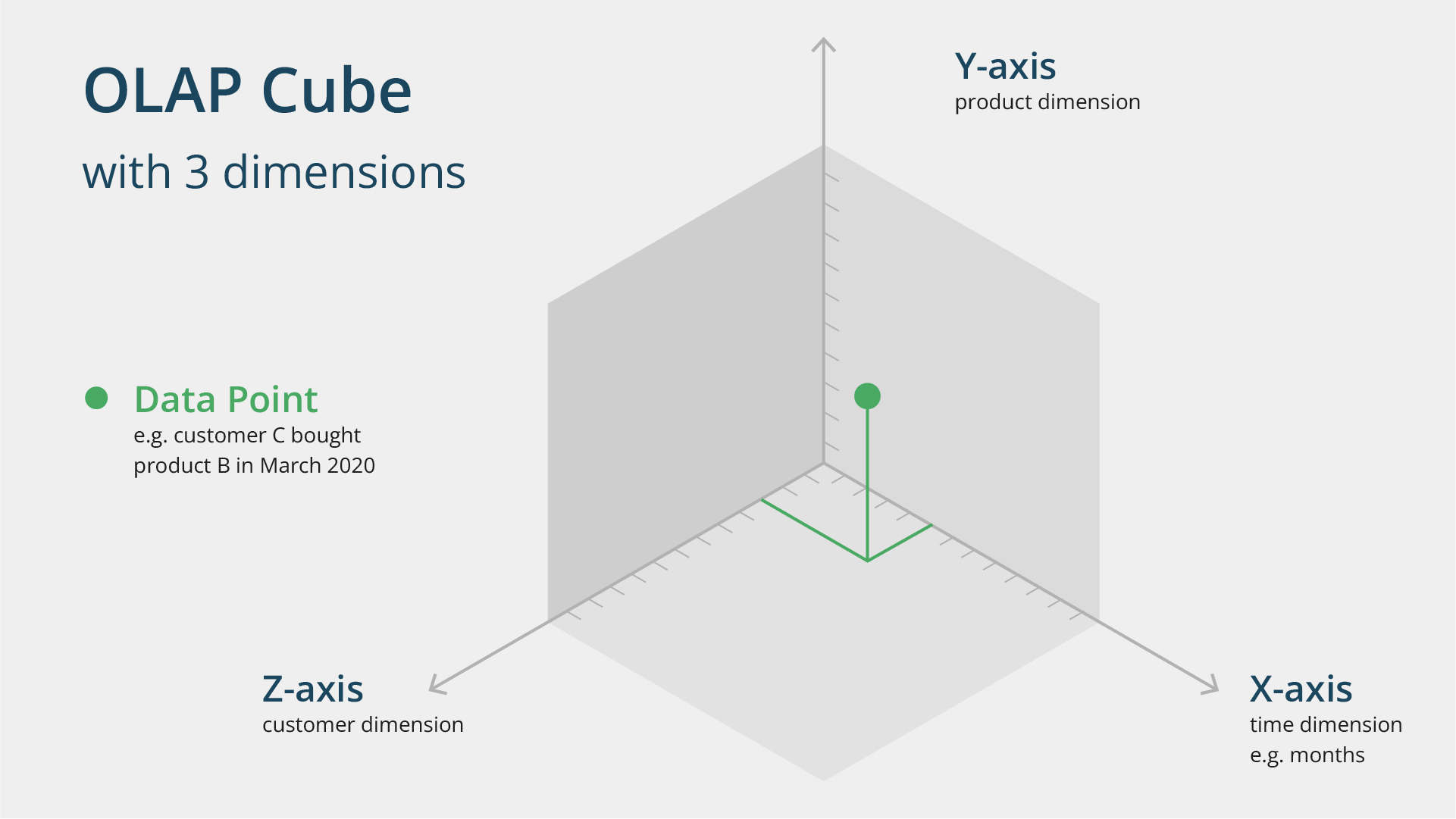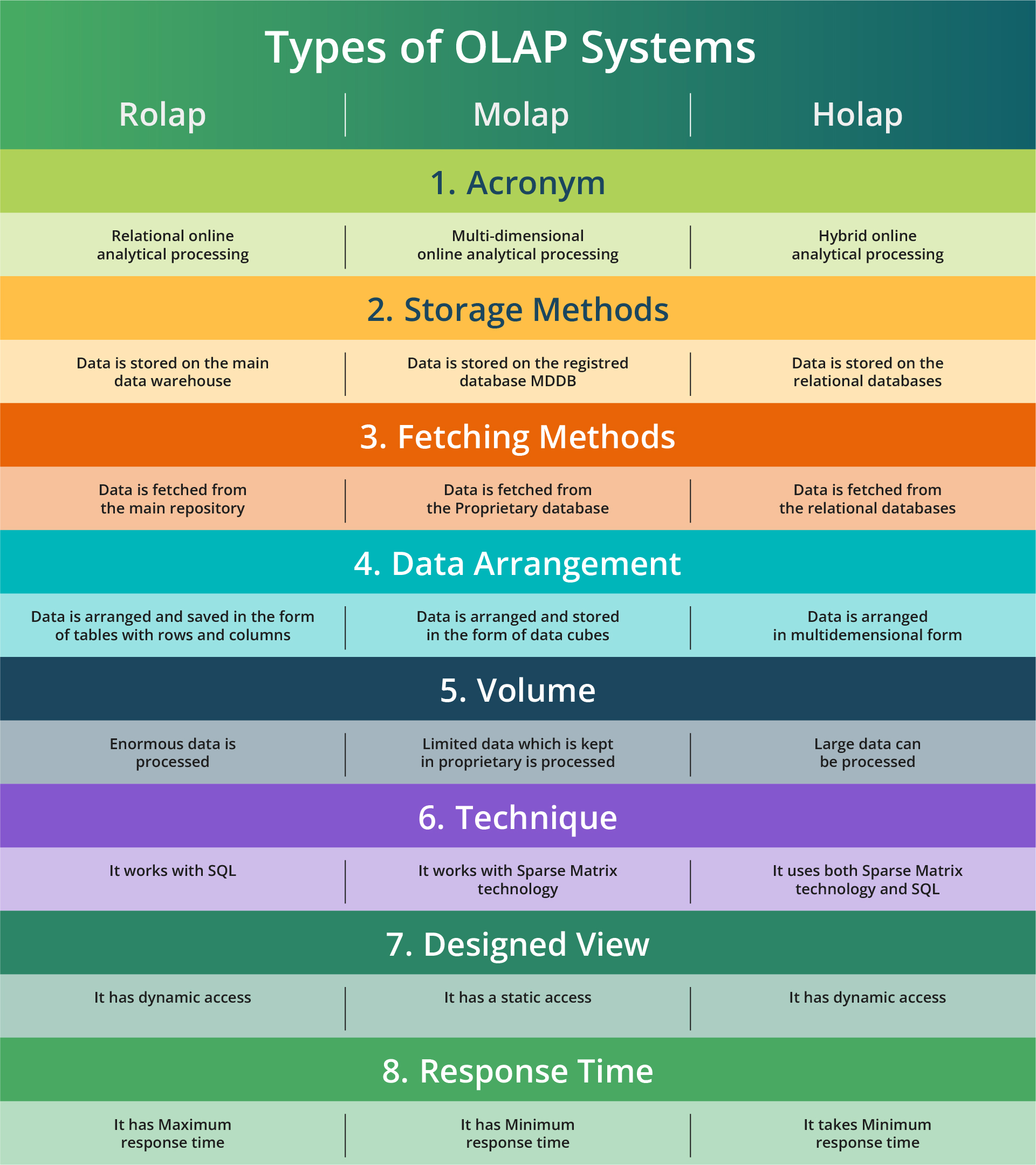
Although less frequently used compared to SQL (relational) and NoSQL (non-relational) data stores, OLAP (Online Analytical Processing) systems play a crucial role for companies managing analytical systems that handle enormous volumes of data—ranging into terabytes and petabytes.
In this article, we will explain the architecture of OLAP, observe its specific types, discuss their differences, and illustrate practical business use cases and future perspectives.
Online Analytical Processing (OLAP) is a powerful software tool that businesses use to analyze data from different angles. Companies gather data from various sources such as websites, applications, and internal systems, storing details about products, sales, and customer behavior.
OLAP combines and categorizes this data to provide valuable insights for strategic decision-making. In simpler terms, it allows analysts to extract specific data sets for analysis in real-time.
Let’s break down how OLAP works in practice.
Imagine a real estate agency needs to assess sales volumes and profitability to identify the most lucrative deals of the past year. This analysis helps them understand the factors influencing property values and the company’s profitability, enabling them to optimize their operations.
Manually extracting data is time-consuming, especially when dealing with different data sources for transactions and financial indicators. Analysts must manually extract the necessary data and identify relationships between them.
OLAP systems automate this process and can work with different data sources containing various types of data, consolidating them based on specified criteria. But that’s not all—after extracting the data, it can be visualized for reporting or detecting relationships between metrics.
In OLAP systems, data is stored either in relational databases or as specialized multidimensional OLAP cubes. The raw data used to build these cubes can be sourced from ordinary databases.
An OLAP cube is a multidimensional array of data, with each facet containing information related to a specific attribute.
Let’s illustrate this using a real estate agency example.
The company might store transaction data in a standard table with real estate agents’ names and the number of contracts they’ve closed. This results in a familiar rows-and-columns format.
But what if we want to examine how each realtor’s transactions are distributed throughout the months of the year? We can add a third dimension to the structure.

This example can be represented in a simple OLAP cube with three metrics. It can be further complicated by adding new metrics, such as property location and city district.
OLAP cubes are used to obtain data slices based on their dimensions. This allows analysts to access information from a single source without manually gathering data from disparate tables.
These data slices across different metrics are automatically generated during data preprocessing, speeding up storage query execution.
The popularity of OLAP technology stems from its unique features.
Users can access any information in full at any time.
It eliminates the need to account for each storage system’s details, configure their interactions, or manually search for specific information.
Information is stored in preprocessed form. Other systems that gather data from multiple databases require more time to respond to queries.
OLAP system users can define the precision and depth of the data provided. For example, they can request a general overview of the total number of company transactions for a year or obtain detailed information about each specific transaction, including date, amount, counterparty, and more.
OLAP systems use one of three data storage approaches: MOLAP, ROLAP, or HOLAP.
Let’s explore each of them.
In MOLAP, primary data and their processed results are stored as classic OLAP cubes, as described in the previous section. This is the fastest method of the three—users can immediately retrieve any desired data slice.
However, MOLAP has its limitations. The processed data results in tables that take significant server memory. Therefore, if there’s a large volume of primary information, MOLAP may not be suitable.
In this approach, both raw data and processed results are stored in relational databases rather than an OLAP cube. This system is simpler in structure since the information resides in regular SQL tables, but it’s slower than MOLAP because retrieving each slice requires querying multiple tables.
HOLAP is a hybrid scheme that combines MOLAP and ROLAP. Primary data is stored in a relational database, while the results of its analysis are stored in a multidimensional cube. This approach is commonly used because it leverages the strengths of both methods.
In the infographic below, you may see the differences among each type of OLAP schemes based on various characteristics.

The concept of multidimensional analysis and OLAP technology has numerous applications in business, assisting companies with organizing and analyzing large volumes of data.
Let’s explore its use cases across different industries.
In sales and marketing, multidimensional analysis allows companies to identify the most profitable segments, considering parameters such as geography, product categories, time periods, and sales channels. OLAP systems enable in-depth analysis of sales dynamics, trend identification, and determination of key success factors.
With multidimensional analysis, companies can create detailed customer segments based on preferences, purchase history, behavioral data, and demographics. This information helps in crafting personalized offers and optimizing targeted advertising strategies and marketing campaigns.
Manufacturing companies use OLAP for analyzing data across all stages of the production process, from raw material procurement to finished goods. The system may analyze production line efficiency, inventory management, or energy consumption.
Multidimensional analysis is applied to optimize inventory management, enabling companies to visualize demand dynamics, production efficiency, and inventory levels. This helps in avoiding excessive warehouse costs and minimizing the risk of product shortages.
Monitoring production processes through multidimensional models identifies production bottlenecks, improves efficiency, and reduces costs. The result is optimized production processes, reduced energy and raw material costs, and improved product quality.
Telecommunications companies use OLAP for analyzing service consumption data, traffic management, and service quality assessment. Network service monitoring involves analyzing the quality of provided telecommunications services, network load analysis, and preventing potential failures. Multidimensional analysis also aids in understanding consumer behavior by providing insights into customer preferences, activity levels, and service usage predictions. Notably, the sheer volume of data requires real-time analysis to swiftly respond to changes.
Despite the wide range of applications and the diversity of the usage, OLAP technologies have several drawbacks.
Let’s take a closer look at the shortcomings of OLAP architecture.
Building multidimensional cubes requires defining hierarchies, dimensions, and data relationships, often requiring experts with deep knowledge of data structures and databases. To simplify this stage, the introduction and use of automated cube design tools can be considered.
Consolidating data from various sources (e.g., databases, data warehouses) requires data collection, transformation, and loading (ETL) management, which can be complex with multiple data sources. A possible solution to this problem lies in the use of modern data integration tools like Apache NiFi, Talend, and Microsoft SSIS.
When dealing with large data volumes, optimization of data storage and processing is crucial for high performance. It is recommended to optimize data warehousing using compression and indexing technologies, along with regular monitoring and system improvements to sustain high performance.
It’s essential to ensure data security by regulating access to multidimensional cubes based on user roles and data access levels. Integration with identity and authentication management systems may help in data security.
Implementing multidimensional analytical systems may require additional investments in server hardware, data warehouses, and specialized software. Leveraging cloud services and regularly updating the technology stack will help optimize costs.
Despite these challenges, the proper implementation and use of multidimensional analysis and OLAP technologies can significantly enhance analytical capabilities and decision-making within organizations.
The future development of OLAP technologies aims to enhance functionality, improve user interaction, and adapt to modern business requirements.
Below are some of the key perspectives:
Combining OLAP with machine learning and AI technologies to automate data analysis and provide more accurate predictions appears to be the logical evolution of this technology. For instance, using machine learning algorithms to uncover hidden patterns in data and suggest more efficient business strategies.
Shifting towards cloud-based OLAP solutions to enhance scalability, flexibility, and cost management is another perspective. This can be done by leveraging cloud data warehouses and OLAP services like Amazon Redshift, Google BigQuery, and Microsoft Azure Analysis Services.
Integrating AR/VR technologies to create interactive environments with data visualization in three-dimensional space will bring deeper data perception.
Through blockchain technology in OLAP systems, companies may ensure data transparency and security.
Using new data visualization methods will help users to understand complex data structures. An example of this may be the application of graphical database technologies to visualize relationships and dependencies in data.
These perspectives represent the evolving landscape of OLAP technologies, emphasizing innovation and adaptation to meet the evolving needs of modern businesses.
This article provides an overview of the current state of OLAP and looks ahead to its future, emphasizing that this technology will continue to evolve, becoming more efficient and adaptable to the dynamics of the modern business landscape.
However, successful implementation and utilization of OLAP requires not only technical expertise but also a deep understanding of specific business processes.
At Kanda, our expert team is dedicated to addressing daily technological challenges. If your company seeks to process large volumes of information for insightful solutions and informed decision-making, we’re here to collaborate and build meaningful solutions together.
Get in touch with our experts and let’s harness the power of innovation to drive business success, together.



